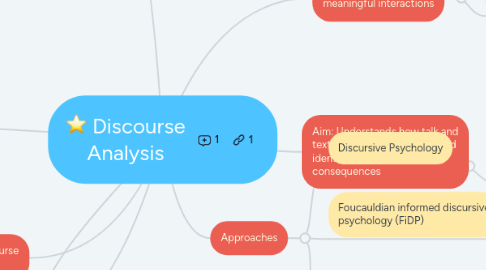
1. Definition:Concerned with talk and language and posits that talk and language construct reality
2. Used a social constructionist epistemological position.
3. Forms of discourse analysis
3.1. Theoretical underpinnings
3.2. Emphasis on WHEN, HOW, WHAT & WHY questions
3.3. Emphasis on the micro and macro elements of talk
4. Data Source
4.1. semi-structured, documents and field notes.
5. Analytical Rigour
5.1. Reflexive journaling
5.2. Peer coding
5.3. Reflection with the research team
6. Discourse: Any form of meaningful interactions
6.1. ways of expressing thoughts.
7. Aim: Understands how talk and text construct ones reality and identify their social consequences
8. Approaches
8.1. Discursive Psychology
8.1.1. Understand what, how and when psychological concepts are used to perform particular actions in social interaction
8.1.1.1. Steps: 1) Devise a research question, 2) Data collection, 3) Transcription, 4) Coding & Analysis
8.2. Foucauldian informed discursive psychology (FiDP)
8.2.1. Focused on Knowledge, truth and power. It uses different discourses -different ways of making sense of the world
8.2.1.1. Steps: 1) Devise a research question, 2) Data collection, 3) Transcription, 4)Analysis
8.3. Causal Layered Analysis (CLA)- Emerging methodology
8.3.1. To get the root of complex social issues. To be used when an issue has multiple layers of complexity
8.3.1.1. Steps: 1. Considering your research question, 2. Data familiarisation 3.Coding between the layers 4. Coding Within the Layers 5. Reconstruction of the issue, 6. Posing alternative futures
8.3.2. 4 layers: Litany, social causative, worldview/discourse & Metaphor/ myths
